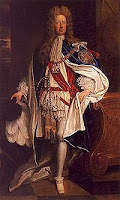 Yes, they became Victorians.
Yes, they became Victorians.
That’s always something that alarms me when I consider our interpretation of the Regency. If not our characters themselves, then certainly the half-dozen babies of the epilogue grew up to become … like this.
Did it happen overnight or was it a gradual change in sensibilities–or, to put it another way, were the Georgians more Victorian than we like to think?
Pretty much, yes. For instance, William Bowdler (1754-1825) published his improved edition of Shakespeare in 1818, the Family Shakespeare, which omitted certain vulgarities which might offend or corrupt the innocence of women and children during family readings. Don’t you think “Out, out crimson spot!” has a certain appeal?
As early as 1710, the modest pamphlet that grew to be the bestselling book of the eighteenth century, Onania: or, The Heinous Sin of Self-Pollution, and all its Frightful Consequences in Both Sexes, Considered, warned against solo sexual activity. Yes, sex for Georgians was fraught with moral peril and the best approach was to grit your teeth, think of England, and try not to enjoy it because this was all about procreation and duty.

 A brief glimpse of fashions during the first couple of decades of the nineteenth century shows women’s clothes evolving from diaphanous muslins with high waists to shaped bodices and puffy sleeves and lowering waistlines, with a shape dictated by corsets and a gradual restriction of movement.
A brief glimpse of fashions during the first couple of decades of the nineteenth century shows women’s clothes evolving from diaphanous muslins with high waists to shaped bodices and puffy sleeves and lowering waistlines, with a shape dictated by corsets and a gradual restriction of movement.
Yes, indeed, dear Mama did appear half naked in public, just like the sensibly dressed young ladies in the cartoon.
 Thackeray’s Vanity Fair, published in 1847-48, was illustrated by the author who showed his characters dressed in “contemporary” clothes.
Thackeray’s Vanity Fair, published in 1847-48, was illustrated by the author who showed his characters dressed in “contemporary” clothes.
Tastes had changed, as Thackeray explained:
It was the author’s intention, faithful to history, to depict all the characters of this tale in their proper costume, as they wore them at the commencement of this century…I have not the heart to disfigure my heroes and heroines by costumes so hideous; and have, on the contrary, engaged a model of rank dressed according to the present fashion.
 Similarly, the painting Before Waterloo by Henry Nelson O’Neil (1868) has not an Empire waistline in sight.
Similarly, the painting Before Waterloo by Henry Nelson O’Neil (1868) has not an Empire waistline in sight.
But within a couple of decades tastes had changed once again and with the passing of time came a certain nostalgia for the past. A genre of painting emerged that showed the big bad Regency as being pretty, cute, and innocent.
 Marcus Stone (1840-1921), Dickens’ friend and later illustrator, painted a series of genre scenes such as this one. It’s related to his painting In Love that HarperCollins, bless their heart, used for the cover of The Rules of Gentility (same characters, same silly hat, same ribbon and basket, and he still hasn’t plucked up the courage to propose to her!).
Marcus Stone (1840-1921), Dickens’ friend and later illustrator, painted a series of genre scenes such as this one. It’s related to his painting In Love that HarperCollins, bless their heart, used for the cover of The Rules of Gentility (same characters, same silly hat, same ribbon and basket, and he still hasn’t plucked up the courage to propose to her!).
 Kate Greenaway (1846-1901) also idealized the period.
Kate Greenaway (1846-1901) also idealized the period.
When you’re reading or writing do you ever consider that the Regency is going to become the Victorian age? Do you want to? Can you imagine the family portraits becoming objects of embarrassment?

 I blame it all on Azteclady who made the suggestion in the discussion following Pam Rosenthal’s recent appearance here. She suggested LOLRegencies, after we talked about the implied silliness of the Elgin picture at right, a marvelous mixed bag of a portrait that begged for a caption. Or several.
I blame it all on Azteclady who made the suggestion in the discussion following Pam Rosenthal’s recent appearance here. She suggested LOLRegencies, after we talked about the implied silliness of the Elgin picture at right, a marvelous mixed bag of a portrait that begged for a caption. Or several. The email address is riskies@yahoo.com. Put LOLRegencies in the subject line, and send your efforts to me before midnight (EST) on Wednesday, November 26.
The email address is riskies@yahoo.com. Put LOLRegencies in the subject line, and send your efforts to me before midnight (EST) on Wednesday, November 26.









